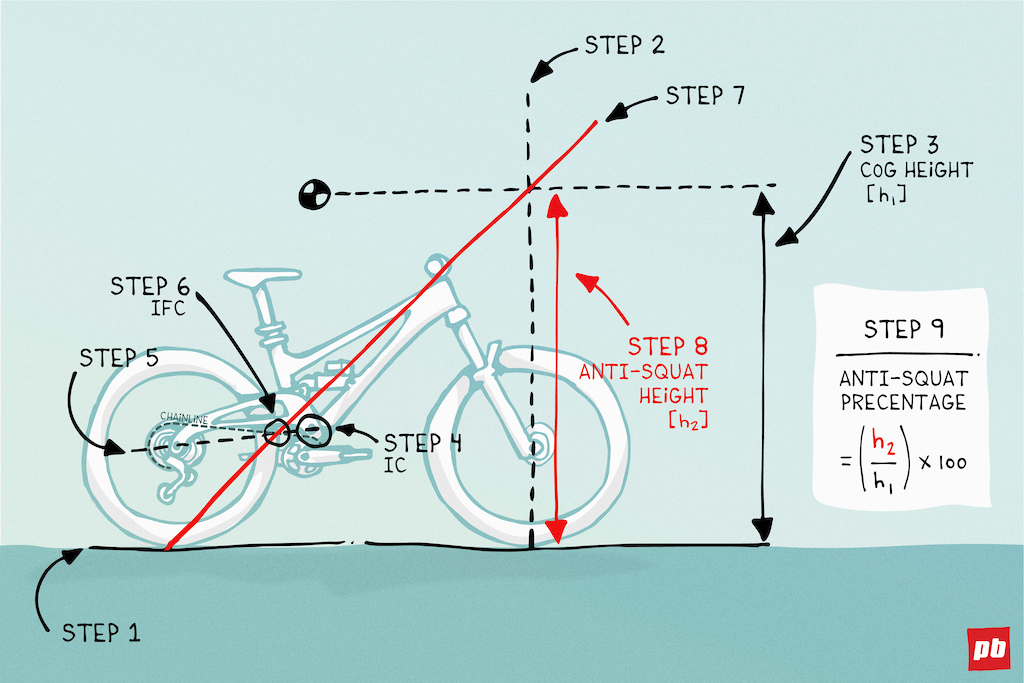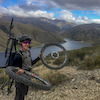Here at Pinkbike, we get inundated with all kinds of questions, ranging from the basic "Can I have stickers" to more in-depth, soul-searching types of queries like if you should pop the question or what to name your first child. Ask Pinkbike is an occasional column where we'll be hand-picking and answering questions that have been keeping readers up at night, although we'll likely steer clear of those last two and keep it more tech oriented.
Over-Forking Geometry ChangesQuestion: @lyfcycles asks in the
All Mountain, Enduro & Cross-Country Forum:
Are there any hard numbers on what over forking a bike by 10mm does to the geometry, HA, BB height, STA etc? I'm looking at picking up a 2020 Top Fuel 8 but immediately replacing the fork. Trek says the frame is designed to be able to take a 130 and since I'm buying a fork anyway I thought maybe I'd get a 34 and just have the air springs for 120 and 130. Just trying to get an idea on how much it is going to slack out the HA and STA mostly.  | Long forking is brilliant. More party up front and potentially more aggressive geometry come from it. But it really depends on the bike's standard geometry as to whether it will work and how much it would change the geometry by.
Taking a standard 2020 Trek Top Fuel 8, there's a Rock Shox Recon Gold RL fork with 46mm offset. This is actually a little different in dimensions as to what Trek state in their geometry of the bike. They quote a 44mm offset, which points at the bike being designed around a Fox fork.
Rock Shox and Fox don't always have the same dimensions for forks with the same travel, and in the case of the 120mm forks the Rock Shox is a shorter axle to crown with a longer offset. So, truth be told, the geometry on your bike as you got it is ever so slightly different to that quoted. That's nitpicking, though, and only makes the head and seat angles 0.1 degrees steeper and changes the rear, stack, bottom bracket height and wheelbase by a single millimeter.
Adding in the 130mm travel 34 changes things a bit more, and guessing that you'd be buying a standard 34, rather than the Step Cast version, which isn't available in 130mm travel, you'd actually have a fairly efficient packaging of 130mm travel in a small axle to crown.
Statically, no rider on the bike, comparing your exact bike spec to a 130mm travel Fox 34 your head and seat angles would slacken half a degree, your BB would raise by 4mm, your reach would get 6mm shorter and your stack would increase 5mm.
For setup, if you took the same 15% fork sag between 120mm and 130mm travel you'd lose 1mm more due to it, but the extra 8mm of fork is still big enough to give a geometry change.
Those are all relatively small changes, but if you're in-tune with your bike then they could be something that you might pick up. Over the top of 10mm more party that is.
|
Long-forking bikes is a common scenario, although, depending on the bike, the geometry changes that arise from it can be good or bad.
Bolts and StuffQuestion: @recklessrye asks in the
Downhill Forum:
Does anyone out there have any clues as to where to find those specific bolts for older bike, without having to call every local bike shop. In particular, I need a rear pivot bolt for a 2006 Norco B-Line. It’s sad because otherwise the bike is in good shape and would be great to save for my youngest son. | Brands would normally have to keep a bunch of spares for bikes that were produced within the last five years. But, given that your bike is from 2006 it's pretty far out of that period. You mentioned not wanting to call every local bike shop, but I'd still recommend trying the Norco dealer closest to you. If they don't have the part in stock, it's possible they could order it in for you, or at least provide you with the exact dimensions.
Failing that, if it's the rear pivot bolt that you're after, you could take the bolt out from the other side down to a machine shop and either see about an existing standard bolt that could fit for the length, diameter, thread and head. Worst case, I imagine they could machine up a new bolt, although it would be the most expensive option.
Once upon a time, while out on holiday in France, the same bolt fell out of my Intense M1, and myself and a bunch of friends managed to find a standard bolt that fit like a dream. It came from the back of a road sign of all places. So, there might be a standard option out there for you.
Failing that, perhaps one of the Pinkbike readers out there has exactly what you need?
|
Keeping old bikes like this 2006 Norco B-line going is a worthy endeavor, but getting hold of specific parts or hardware can be really tricky with these older generation bikes.
Anti-Squat & Waste of EnergyQuestion: @Will-narayan asks in the
Mechanic's Lounge Forum:
Is having anti-squat as much a waste of energy as pedal bob? | Will-narayan asked, in a pretty extensive post, about the idea that if energy is lost to heat in the damper due to pedal bob, then wouldn't the forces of anti-squat also rob the same energy and make it harder to pedal. It's a really interesting question. One that can get very deep into physics quickly and to have a definitive answer needs a good dose of calculation, and assumption, to come out with numbers behind the answer.
Rather than have the idea that with anti-squat a bike would be harder to pedal, let's say that the amount of energy input into the bike system is fixed, and look at where it could be lost to instead of what you really want, the bike going forwards.
A bike with a lot of pedal bob, potentially because of very low anti-squat levels, would indeed have some of the rider input energy lost in compressing the shock when you try to accelerate forwards. While the acceleration might be the same as a bike with higher anti-squat, the reaction of the system due to the acceleration and ensuing load transfer would be very different.
A bike with enough anti-squat to counteract the tendency to squat due to the load transfer would also need some energy taken from the rider to have this. The load transfer due to the acceleration still happens, just that it results in less or no squat. The response from the bike due to the acceleration is then very different to a bike with lots of pedal bob.
Physically quantifying how much energy is taken from the rider in each case is something I haven't done, unfortunately. I'd need the assistance from some of the bigger minds in the bike industry to have accurate numbers and so a good comparison.
But overall, it's more favourable to have a bike that doesn't bob excessively when we pedal. Having had the chance to ride bikes with removable idlers, and so have the exact same bike and setup just with altered chain lines and anti-squat amounts, I can say with complete confidence that it was a lot more exhausting riding around on the bike with drastically reduced anti-squat. So much of the energy invested in the system was spent in squashing the suspension rather than going in the direction I wanted to go.
We've already looked a lot at anti-squat in our Enginerding article, and there will be more in the future on different topics. But your comparison of the two scenarios and energy lost is something that we'll look at calculating and definitively commenting on.
|
Anti-squat is one way of combating the effects of load transfer when we accelerate, but it does need some energy to do it. But how much energy compared to that lost in suspension bob on a bike with low levels of anti-squat?





It's poor customer service for sure but that's the business they are in.
In my experience, the best way to get something small (like hardware) from some of this big brands is to find the regional sales rep or the brand marketing person. They tend to be riders and are usually willing to help out within reason.
No movement + no heat = no energy
Energy/Work = Force x Displacement along the acting line.
It's a simplification easier to understand, for those fearing their high antisquat bikes are somewhat less efficient.
Hopping over them may be simple, but that takes even more energy to do. I still think my hardtail was the most efficient bike I had as a whole, but some rooty extended climbs on trails near me are much easier and take much less energy on my short travel DW-link bike.
My hardtail was also a 26"...Im sure that made a difference too. It wasa very playful bike and a blast to ride. I will likely build another hardtail in the future with bigger wheels.
I'd like to know how efficient the high anti squat is pedaling over small bumps versus a couch like my coil shock Enduro. A bike with high anti squat means you have the bike and the rider having to be lifted over the bump.
Ho hum, only kidding Waki...
(this is not an attack on WAKI- the guy has lots of good and bad contributions to PB and I often like reading his comments)
I have friends who just ride, I have friends who like to tinker and talk tech...some are good and some bad on both sides.
You’re right that the majority of rippers don’t get bogged down with the details, but that doesn’t mean there’s anything wrong with the details or taking interest in them...
Think it's broken? Ask your local machine shop, they know what they're doing and it might save you hundreds....
There are usually much better ways to create a more confident bike:
Namely an angleset or maybe even offset bushings.
And if you just want more travel without affecting geo too much then look a a fork with a shorter a-c measurement like mrp’s offerings. 10mm free vs rockshox
The anti-squat is good, but not perfect on a triple chainring on a 2011 way overforked (130/100mm) xc bike.
My take is that you preserve so much energy just letting your bike take the small bumps instead of easying the bum out of the saddle.
160travel is not the important part either, it’s solely the geo.
I realize the OP referenced beating strava times, but the point stands regardless.
I’ve never experienced a version of myself that could attack on the dh bike but was a slug on my AM loops, fitness and shredding go hand in hand imo.
If you just want to get sideways at the park I get it, but I don’t leave close to one
Rocky mountain have the "ride 9" or something like that.
It's useful the firts 4 rides, when you play with the adjustments. then it becomes boring , you put it in the most "aggressive" position and you don't touch it anymore.
most fasteners are offered in a few different materials and you can even find funky stuff like shouldered bolts with low heads.
The best part about Misumi is that you can order singles of bolts without paying OTA.
I think someone else already mentioned McMaster for Standard hardware; pricey, but whatever gets you rolling!
Let's imagine the simplest system. To get rid of rider movements and weight transfers like legs flailing around we replace the rider with an electric motor on the crank. The bike has 100% anti squat. When we turn the motor on, the bike goes forward and has no vertical motion. If there is no vertical motion then no work is done. If no work was done in that axis then no power was consumed. It just zeroes out. Now imagine a bike with 200% antisquat. The bike goes from sag, to less than sag when we turn the motor on. Work was definitely done in that period (some of which converts to heat in the suspension). Now imagine it's a meatbag pedaling. You are like the worlds shittiest electric motor, you output a sinusoidal power form. The suspension anti-bobs you up as you push down on the pedal, then as you go past 12-6 o'clock the suspension goes back to sag and then you repeat that 180 times a second for a cadence of 90. On flat ground your vertical axis would look like a pogo stick. That's a lot of work you are doing which doesn't make you go any faster!
0% antisquat is the same thing but in reverse (this is harder to imagine, which is why I started with the 200% example). A lot of bikes have more than 100% antisquat (at least in certain gear/travel combinations).
So while there is such a thing as too little anti-squat. There is also, definitely, such a thing as too much.
"But my bike has 100% antisquat and I still see my shock moving!" Yes, cause there is more going on than just your pedal force input. You are literally flailing around on top of the bike, so that causes shock movement too as you are changing the center of gravity of the system etc. This is why we should all ride rigid bikes and enduro is dumb. QED
Now is that everything going on? No, but I think it's a pretty quick and simple explanation of a lot that is happening.
How is reach going to affected more than stack? Head tube angles are still above 45, so an increase in the fork axle-to-crown (hypotenuse of the triangle) is going to increase the height of the top of the head tube (stack, "opposite" side of the triangle) more than it pushes the top of the head tube back (part of reach, "adjacent" side of the triangle).
Since:
work = force x distance
and, power = work / time
if suspension movement is zero then work done on the suspension is zero, therefore power (watts) lost to the suspension is zero.
You could argue this doesn't really illustrate the situation for humans however since holding up a weight (zero movement, therefore, zero work) still takes energy from you. A bike isn't static though, the energy you put into the pedals has to go somewhere. Since the chain tension trying to extend the suspension is balanced by your weight moving back onto the rear suspension the forces cancel out. The energy isn't converted into heat in the damper as it would if the bike was experiencing pedal-bob and it can't just disappear so it must be going into accelerating you.
Looking at it another way you are putting the same pedaling forces into a hardtail frame and they are trying to flex the frame (just like they are trying to make your suspension move). The hardtail frame doesn't flex (much) though and the energy goes into moving you forward.
Do we really think that most of us PB readers would notice such tiny differences? Especially after we haven't been riding at our "full potential" for several weeks if not months/years?
And while the old 40-years-ago "hot stove league" of discussions during the winter months in baseball was always intellectually stimulating, it was really a way to keep us hoping to generate discussion and readership. PB: take the cue!!!!!
Wouldn't a good 30-minute strength/mobility/range of motion session be more productive and beneficial? :-)
So, all things being equal with the riders energy input, if you have too little antisquat, some rider energy will go into compressing the shock where some of the energy is dissipated in the damper and lost as heat.
What if you have too much antisquat? Wouldn't some of the rider's energy go into extending the shock (up from sag) where some of the energy is dissipated in the damper and lost as heat?
EDIT: A bike with too little AS might go from sag through to 100% compression due to accelarating forces. A bike with too much AS might go from sag to 0% compression. I can imagine that the damping forces and heat lost to too little AS plowing you through to 100% compression are much larger than the damping forces and heat loss that come from too much AS pogoing you from sag to 0% compression.
bikegeo.muha.cc
So now there's a road sign missing a bolt?